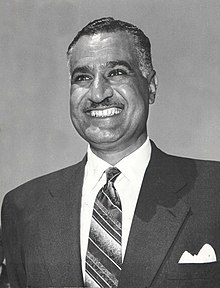
Back Gamal Abdel Nasser Afrikaans Gamal Abdel Nasser ALS جمال عبد الناصر Arabic جمال عبد الناصر ARY جمال عبد الناصر ARZ Gamal Abdel Nasser AST Gamal Abdel Nasser Aymara Camal Əbdül Nasir Azerbaijani Ғәмәл Әбдел Насыр Bashkir Gamal Abdel Nasser BCL
Gamal Abdel Nasser | |||||||||||||||||||||||||||||||||||||||||||||||||||||||||
|---|---|---|---|---|---|---|---|---|---|---|---|---|---|---|---|---|---|---|---|---|---|---|---|---|---|---|---|---|---|---|---|---|---|---|---|---|---|---|---|---|---|---|---|---|---|---|---|---|---|---|---|---|---|---|---|---|---|
جمال عبد الناصر | |||||||||||||||||||||||||||||||||||||||||||||||||||||||||
 Nasser in 1962 | |||||||||||||||||||||||||||||||||||||||||||||||||||||||||
| 2nd President of Egypt | |||||||||||||||||||||||||||||||||||||||||||||||||||||||||
| In office 23 June 1956 – 28 September 1970 | |||||||||||||||||||||||||||||||||||||||||||||||||||||||||
| Prime Minister | See list
| ||||||||||||||||||||||||||||||||||||||||||||||||||||||||
| Vice President | See list
| ||||||||||||||||||||||||||||||||||||||||||||||||||||||||
| Preceded by | Mohamed Naguib | ||||||||||||||||||||||||||||||||||||||||||||||||||||||||
| Succeeded by | Anwar Sadat | ||||||||||||||||||||||||||||||||||||||||||||||||||||||||
| 31st Prime Minister of Egypt | |||||||||||||||||||||||||||||||||||||||||||||||||||||||||
| In office 19 June 1967 – 28 September 1970 | |||||||||||||||||||||||||||||||||||||||||||||||||||||||||
| President | Himself | ||||||||||||||||||||||||||||||||||||||||||||||||||||||||
| Preceded by | Mohamed Sedki Sulayman | ||||||||||||||||||||||||||||||||||||||||||||||||||||||||
| Succeeded by | Mahmoud Fawzi | ||||||||||||||||||||||||||||||||||||||||||||||||||||||||
| In office 18 April 1954 – 29 September 1962 | |||||||||||||||||||||||||||||||||||||||||||||||||||||||||
| President |
| ||||||||||||||||||||||||||||||||||||||||||||||||||||||||
| Preceded by | Mohamed Naguib | ||||||||||||||||||||||||||||||||||||||||||||||||||||||||
| Succeeded by | Ali Sabri | ||||||||||||||||||||||||||||||||||||||||||||||||||||||||
| In office 25 February 1954 – 8 March 1954 | |||||||||||||||||||||||||||||||||||||||||||||||||||||||||
| President | Mohamed Naguib | ||||||||||||||||||||||||||||||||||||||||||||||||||||||||
| Preceded by | Mohamed Naguib | ||||||||||||||||||||||||||||||||||||||||||||||||||||||||
| Succeeded by | Mohamed Naguib | ||||||||||||||||||||||||||||||||||||||||||||||||||||||||
| |||||||||||||||||||||||||||||||||||||||||||||||||||||||||
| Personal details | |||||||||||||||||||||||||||||||||||||||||||||||||||||||||
| Born | Gamal Abdel Nasser Hussein جمال عبد الناصر حسين 15 January 1918 Alexandria, Sultanate of Egypt | ||||||||||||||||||||||||||||||||||||||||||||||||||||||||
| Died | 28 September 1970 (aged 52) Cairo, United Arab Republic | ||||||||||||||||||||||||||||||||||||||||||||||||||||||||
| Resting place | Gamal Abdel Nasser Mosque | ||||||||||||||||||||||||||||||||||||||||||||||||||||||||
| Political party | Arab Socialist Union | ||||||||||||||||||||||||||||||||||||||||||||||||||||||||
| Spouse | |||||||||||||||||||||||||||||||||||||||||||||||||||||||||
| Children | 5, including Khalid Abdel | ||||||||||||||||||||||||||||||||||||||||||||||||||||||||
| Profession |
| ||||||||||||||||||||||||||||||||||||||||||||||||||||||||
| Signature |  | ||||||||||||||||||||||||||||||||||||||||||||||||||||||||
| Military service | |||||||||||||||||||||||||||||||||||||||||||||||||||||||||
| Allegiance | |||||||||||||||||||||||||||||||||||||||||||||||||||||||||
| Branch/service | Egyptian Armed Forces | ||||||||||||||||||||||||||||||||||||||||||||||||||||||||
| Years of service | 1938–1952 | ||||||||||||||||||||||||||||||||||||||||||||||||||||||||
| Rank | Lieutenant colonel | ||||||||||||||||||||||||||||||||||||||||||||||||||||||||
| Battles/wars | 1948 Arab–Israeli War | ||||||||||||||||||||||||||||||||||||||||||||||||||||||||
Gamal Abdel Nasser Hussein[a] (15 January 1918 – 28 September 1970) was an Egyptian military officer and politician who served as the second president of Egypt from 1954 until his death in 1970. Nasser led the Egyptian revolution of 1952 and introduced far-reaching land reforms the following year. Following a 1954 assassination attempt on his life by a Muslim Brotherhood member, he cracked down on the organization, put President Mohamed Naguib under house arrest and assumed executive office. He was formally elected president in June 1956.
Nasser's popularity in Egypt and the Arab world skyrocketed after his nationalization of the Suez Canal Company and his political victory in the subsequent Suez Crisis, known in Egypt as the Tripartite Aggression. Calls for pan-Arab unity under his leadership increased, culminating with the formation of the United Arab Republic with Syria from 1958 to 1961. In 1962, Nasser began a series of major socialist measures and modernization reforms in Egypt. Despite setbacks to his pan-Arabist cause, by 1963 Nasser's supporters gained power in several Arab countries, but he became embroiled in the North Yemen Civil War, and eventually the much larger Arab Cold War. He began his second presidential term in March 1965 after his political opponents were banned from running. Following Egypt's defeat by Israel in the Six-Day War of 1967, Nasser resigned, but he returned to office after popular demonstrations called for his reinstatement. By 1968, Nasser had appointed himself prime minister, launched the War of Attrition to regain the Israeli-occupied Sinai Peninsula, begun a process of depoliticizing the military, and issued a set of political liberalization reforms. After the conclusion of the 1970 Arab League summit, Nasser suffered a heart attack and died. His funeral in Cairo drew five to six million mourners, and prompted an outpouring of grief across the Arab world.
Nasser remains an iconic figure in the Arab world, particularly for his strides towards social justice and Arab unity, his modernization policies, and his anti-imperialist efforts. His presidency also encouraged and coincided with an Egyptian cultural boom, and the launching of large industrial projects, including the Aswan Dam, and Helwan city. Nasser's detractors criticize his authoritarianism, his human rights violations, his antisemitism, and the dominance of the military over civil institutions that characterised his tenure, establishing a pattern of military and dictatorial rule in Egypt which has persisted, nearly uninterrupted, to the present day.
- ^ "Nasser". Collins English Dictionary. HarperCollins. Retrieved 9 March 2020.
- ^ "Nasser". Merriam-Webster.com Dictionary. Merriam-Webster. Retrieved 9 March 2020.
Cite error: There are <ref group=lower-alpha> tags or {{efn}} templates on this page, but the references will not show without a {{reflist|group=lower-alpha}} template or {{notelist}} template (see the help page).

